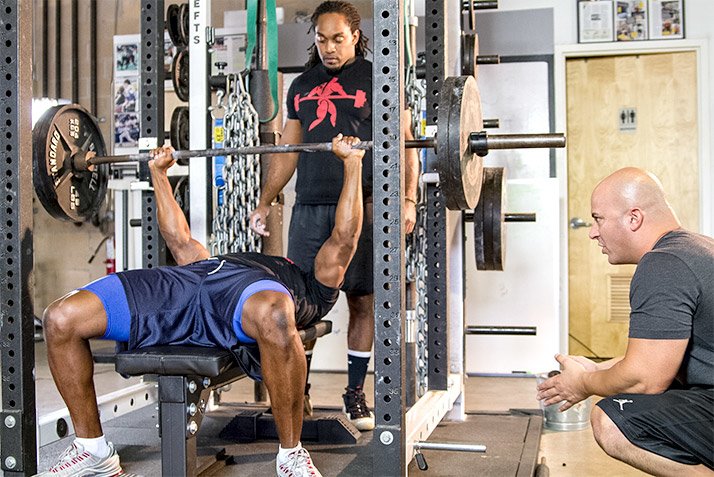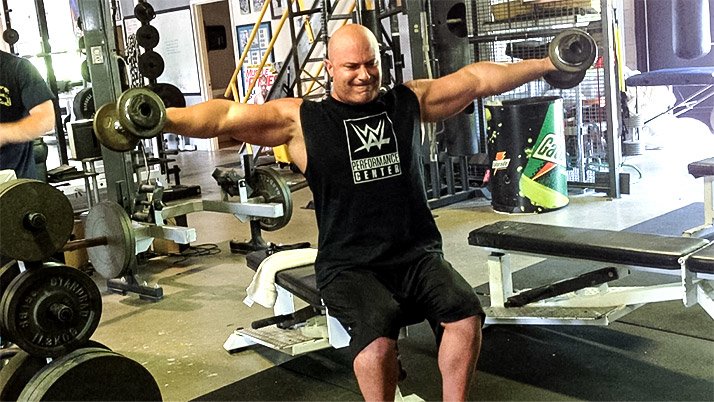
Joe DeFranco's Complete 3-Week Strength Reboot!
Lifting near your max regularly can leave you feeling, well, maxed. Step away from pain and into this 3-week program that will help you feel good and prepare for whatever comes next!
Strength: It's not just for powerlifters anymore. Women and men, bodybuilders and weekend athletes—everyone seems to want to move more weight these days. And that's awesome! But let's be honest: For a lot of us, it also brings some problems. Or, more specifically, some pain.
Seasoned heavy lifters are really good at convincing themselves that it's all part of the game. Some of them brag about their achy joints, shoulders that bark in the middle of the night like they're the powerlifting equivalent of merit badges.
So what's the solution—a deload week? You mean doing the same thing that's hurting you, only with less weight, before going back to big, painful weights again? There must be a better way. And there is. It's this three-week cycle!
This program comprises the first three weeks of our 10-week "Built 2 Last" program. Unlike most other strength-focused programs, it drastically reduces the stress on your joints, as well as your central nervous system. But along the way, it also helps patch the cracks that are causing you pain, setting you up to get even stronger!
Lift bigger, feel better—yes, it is possible! Start it now and thank us later.
Submaximal training starts with your max
You need to know your real maxes on the barbell bench press, squat, and deadlift before you begin this program! Make sure these are your real maxes—no help from your spotter, no guessing, no bullshit! Get your real max.

Here's why: If you lie to yourself and use a max that's too heavy, it will screw up the entire program. It's much better to be conservative with your max on this program, compared to overshooting and going too heavy.
In other words, if you squatted 405 pounds in the gym, but the rep was a total "grinder" that made your eyeballs bleed, your lungs collapse, and you gave yourself a hernia, we would recommend using 365 or 385 as your "max" when figuring out your percentages on this program.
Just to be clear, doing this does not make you lazy or an underachiever—it makes you smart. As you will read in the next section, we have built in "rep records" that will prevent you from not doing enough.
Note: Whenever you're figuring out your percentages and it comes to an odd number, always round the number down. For example, you will be performing narrow-grip barbell bench presses with 70 percent of your max bench press on Day 1 of Week 1. Let's say your max bench press is 275 pounds. When you multiply 275 x 70 percent, you get 192.5 (275 x.7 = 192.5). In a case like this, we recommend rounding that number down, so you would be performing your work sets with 190 pounds (as opposed to rounding up and training with 195 pounds).
A New Way to Bench
We use the narrow-grip bench press and the six-second eccentric dumbbell bench presses in this program. This is because we've found both of these exercises have a great carryover to the regular barbell bench press while being extremely shoulder-friendly. They both build incredible triceps strength, as well.
If you're into math, here it is in equation form:
Less shoulder pain + strong triceps = happy meathead with a big bench.

Why so slow with the dumbbells? Slowing down the tempo of the eccentric (lowering) phase of the bench press for a six-second count will help you develop more control and stability through the entire range of motion. Also, the elastic energy typically accumulated during a more rapid downward stroke will be dissipated, which means you'll develop more starting strength out of the bottom of the bench.
Finally, a more controlled lowering of the dumbbells will create more muscular damage due to increased time under tension. This builds more muscle mass in the chest, shoulders, and triceps. These sub-max eccentric benches will help build a great foundation for moving serious weight using isometric and concentric training—the linchpins of the remaining seven weeks of the full Built 2 Last program.
"Strength Capacity" Circuits
You'll notice that all of the accessory exercises on upper-body workouts are performed in circuit fashion. But rest assured, these aren't your momma's traditional circuits, where insignificant resistance is used for an endless number of reps. We like to call these circuits strength-capacity circuits.
Our circuits incorporate challenging weights and lower rep ranges in order to build strength and muscle, and they simultaneously deliver a conditioning benefit. The exercises we pair together in these circuits don't compete with one another, which allows you to handle heavier weights, with better form, for a longer period of time.

We've found these strength-capacity circuits work wonders for improving body composition and work capacity. They also enable you to have a great workout without spending all day in the gym. If you're like us and you hate traditional steady-state cardio, you're about to discover a much better way to get lean.
However, it's crucial that you choose the proper weight for the exercises in the strength-capacity circuits. You want the weight for each exercise to be moderately heavy, but not maximal. You should never miss a rep or need help with any exercise in the strength-capacity circuits.
Rest just enough, but no more
One of the goals of the strength-capacity circuits is to improve your work capacity, so you need to train at a quick tempo. But you don't have to run from exercise to exercise when performing the strength-capacity circuits. That might work with teeny-tiny weights, but not here.
You will see notes in the workouts that tell you to take about 10-20 seconds between each exercise. This is enough time to walk over to the next exercise and get properly set up. Speaking of setting, make sure to set up all 4-5 exercises of the circuit ahead of time!
We did everything in our power to make the exercise pairings and strength-capacity circuits as convenient and realistic to perform as possible, so you shouldn't be running all around the gym looking for equipment and setting up as you go along. Nevertheless, set up all the dumbbells, benches, and other equipment in the same general area so you can train at an intense pace and focus on exercise technique.
You'll also notice that we only used mainstream gym equipment in this program. There aren't any specialty pieces of equipment or items. All you need are barbells, dumbbells, your body weight, and an occasional medicine ball and mini band. So there are no excuses!
One lower-body workout a week
Yup, you read that right: You've only got one leg day per week.
There are a few reasons for this. We've noticed that the washed-up meathead population can only take so much stress. Because they don't lift for a living, there are outside factors stressing the body that limit recovery, such as work, stress, kids, relationships.
We feel that performing two leg days with this type of program would be counterproductive for a lot of people.
You'll also notice that during these three "strength reboot" weeks, squats and deadlifts are performed in a supplemental fashion. By this we mean:
- Lighter weights: 55 percent for the deadlift, for example
- Unilateral split squats instead of back squats
- Focusing on eccentric lowering in the squat, rather than concentric pushing
The purpose of performing these lifts in a supplemental fashion is to properly train and develop the movements before you go back to lifting max weight in the future. Over these three weeks, you'll get a training stimulus while decreasing muscle soreness, joint stiffness, and risk of injury. We really want you to be built to last!
It all starts with the warm-up
It is critical that you warm up properly before every training session—even submaximal ones! Warming up needs to become a habit if you're looking to stay healthy, feel good, and enjoy lasting gains.
Remember that this program is about being built to last—it's not about being built for two weeks and then tearing your hammy and missing two months because you didn't warm up.
We've provided two of our most practical and effective warm-ups for both upper- and lower-body workouts. Do not skip these warm-ups! Then, once you complete your warm-up, perform 2-3 warm-up sets of your first exercise before getting into the working sets.
Defrancostraining.com Iso hold Y-W-T
Watch the video - 00:22
For example: Day 1 has you supersetting narrow-grip barbell bench presses with iso-hold Y-W-T's. But don't just throw 70 percent of your max on the barbell and jump right into it. In this case, we recommend performing three warm-up sets of the narrow-grip barbell bench press before you start your four working supersets.
For example, you could perform 8 reps at 35 percent, 6 reps at 50 percent, and then 4 reps at 60 percent before you start your working sets.
Resist the urge to do it every day
This program is best performed on nonconsecutive days. If for some reason your schedule doesn't permit this, you can perform an upper-body workout and lower-body workout on back-to-back days. Just make sure to get at least 48 hours between the two upper-body workouts.
One of the questions we anticipate getting from the highly motivated crowd is, "How come we're only training three days a week? I want to train more!"
Here's the deal: Even this submaximal strength program is a strength program. It will definitely improve your overall fitness levels as well, but you should categorize this program as the strength portion of your overall weekly plan. That's why it's "only" three days a week. (And FYI: we put the word "only" in quotes because you will quickly realize that three days a week is plenty on this program. Trust us.)

The beauty of this three-day split is that it gives you four other days of freedom to do what you like! When designing workouts for the public, it's impossible to please everyone, so we decided to develop the hard part, so you can go out and have fun doing what you like during the rest of the week. And that's obviously going to be different for everyone.
Here are some examples:
- WWE superstar Triple H added a sled-dragging workout during the weekend while he was on this program. He would also perform incline treadmill walking with a weight vest on his nonlifting days during the week.
- We had some former athletes who liked to run hill sprints, push the prowler, or incorporate some battle-rope workouts once or twice a week while on this program.
- A few parents told us that they went for a bike ride or played basketball with their kids on their off days.
- A bunch of people preferred to do some low-intensity cardio in between the workouts.
- And some guys did absolutely nothing on their off days.
As you can see, there are endless possibilities. Make this program your program. Enough of the small talk—it's time to train!
